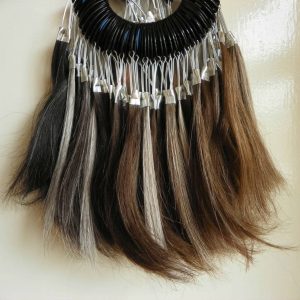
Hair extensions are a popular product used to create extra hair length or volume. They may be made of human hair (up to 250 hairs) or artificial hair. There are several types that are attached to the original hair in different ways. These include clip-ins, weaves (sewn to a braided corn row), pre-bonded with adhesive (attached with heat), tape, and micro-link (attached with metal rings). Hair extensions may cause stress and pulling on the natural hair by creating friction during sleep and by adding weight when the hair is wet. Constant pulling of the hair from extensions can create traction alopecia (hair loss). This may also happen from constant tension with tight ponytails, braids, corn rows, buns, head pieces, and head coverings.1,2 The tension may pull the hair out at the roots completely or create inflammation of the hair follicles which causes them to weaken and stop producing hair. Traction alopecia is evident when the pattern of hair loss is in the same pattern as the source of the tension.
Prevention
Many people wearing hair extensions may not be aware that they have traction alopecia.3 There is a reversible phase when removing the cause of the tension may allow hair to return to normal. If hair does not return to normal within 6-9 months after removing the source of the problem, hair loss may be permanent. If hair loss is permanent, hair transplantation may be used to restore living hair to the areas. In order to prevent traction alopecia, hair extensions should be fitted by a trained professional. Extensions should also be removed as often as possible; clip-ins removed before bed may help prevent hair loss compared to other types of extensions. If you think you may have traction alopecia, please contact your dermatologist.
Article by: M.A. MacLeod, MSc., Mediprobe Research Inc.
References
- Ahdout J, Mirmirani P. Weft hair extensions causing a distinctive horseshoe pattern of traction alopecia. J Am Acad Dermatol. 2012;67(6):e294-e295. doi:10.1016/j.jaad.2012.07.020.
- Khumalo NP, Jessop S, Gumedze F, Ehrlich R. Hairdressing and the prevalence of scalp disease in African adults. Br J Dermatol. 2007;157(5):981-988. doi:10.1111/j.1365-2133.2007.08146.x.
- Yang A, Iorizzo M, Vincenzi C, Tosti A. Hair extensions: a concerning cause of hair disorders. Br J Dermatol. 2009;160(1):207-209. doi:10.1111/j.1365-2133.2008.08924.x.












